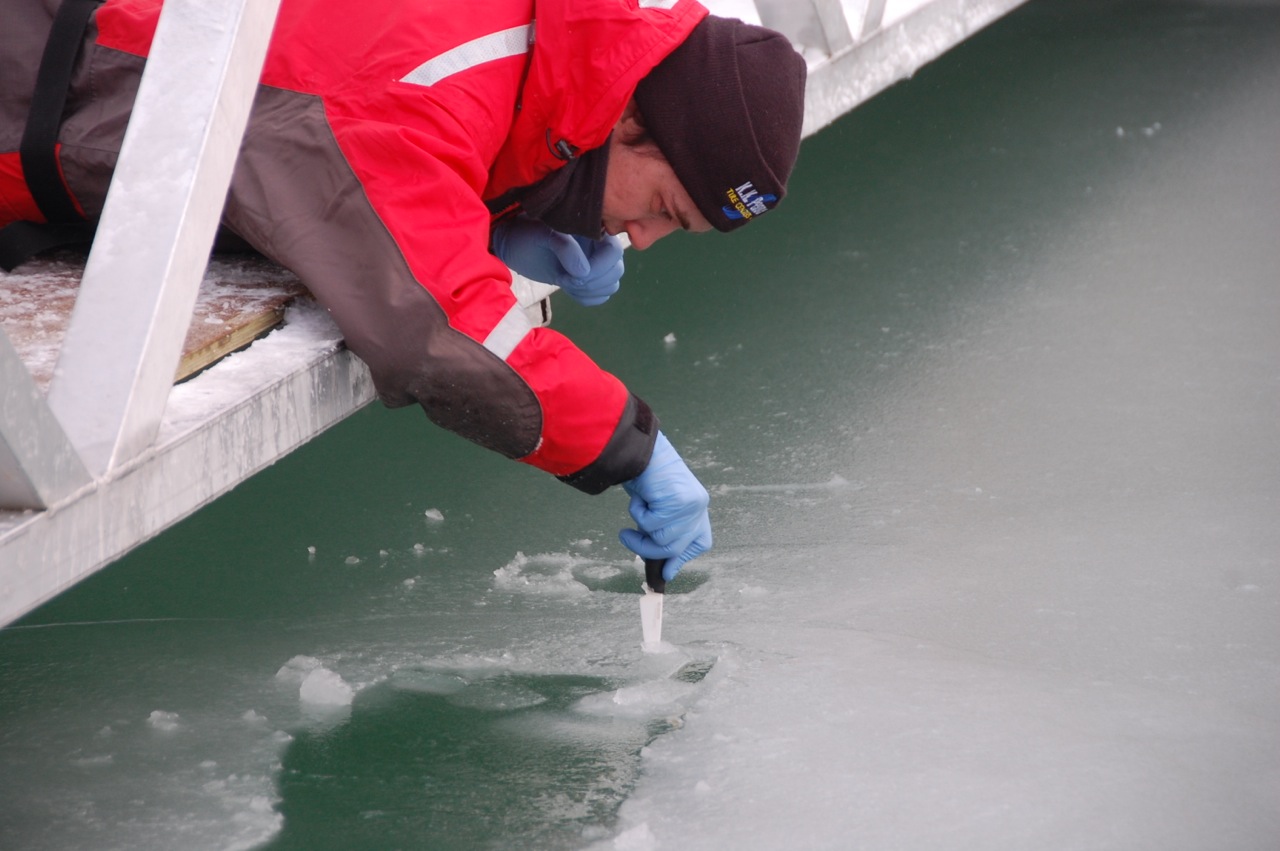2013 SERF Experiment - Blogs

2013 SERF Experiment - Blogs
Submitted by: Sarah Beattie, CEOS/UofM
Evolution of mercury within ice
I am investigating the incorporation and temporal evolution of mercury (Hg) within sea ice and other ice – associated features such as frost flowers, brine and surface snow. Total Hg, dissolved Hg and particulate-bound Hg will be measured in the artificial sea ice and seawater to explore the hypothesis that aquatic particles with bound mercury provide a nucleation point for ice formation, and thus through this mechanism Hg becomes incorporated into the sea ice. A high sampling frequency during initial ice formation and growth will provide the temporal resolution necessary to capture this and other mechanisms. This information in combination with atmospheric Hg measurements being conducted by Dr. Feiyue Wang will allow for the transport of Hg across the Ocean – Sea-Ice – Atmosphere interface over time to also be investigated. In the wake of a shift from a multiyear to a first-year sea ice regime across the Arctic, this mechanism-based mesocosm work will aid in the understanding of Hg cycling and uptake by first-year sea ice.
Submitted by Alex Hare, CEOS/UofM
Sea ice chemistry and carbon flux
I am examining the pH of the seawater/sea ice system as the seawater freezes and separates into distinct forms: exterior and internal sea ice, sea ice brine, and frost flowers. The information obtained provides a different perspective on the consequence of ice formation on carbon dioxide movement through ice compared to other CO2-focused projects. The result is a better picture of how the carbonate system is affected by, and affects in turn, sea ice chemistry. In addition, the information may help us refine our understanding of ice surface-related chemical processes that have atmospheric implications, such as reactive bromine formation and related localized ozone and mercury depletion events. Based on results we obtained last year at SERF, we believe that a "C-shaped" pH profile exists in sea ice essentially devoid of biological activity, which may have a variety of implications to both the atmospheric and biological fields of study. The pursuit of more information about this discovery is the focus of my work at SERF this year.
Submitted by Rosina Grimm and Leif Riemenschneider, Max Planck Institute for Meteorology
In situ measurement of salinity and solid fraction of growing sea ice
Our measurement technique is based on impedance measurements between platinum coated wires around which the sea ice grows. The vertical spacing of the electrodes is 1 cm in the upper 9 cm of the ice, and 1.9 cm below to a total depth of 30 cm. Additionally, the temperature is recorded at each depth level. Using the impedance and temperature measurements we can infer the salinity and solid fraction of the ice. These measurements are useful to study the small scale structure of the sea ice as well as brine dynamics.
Submitted by Lise Lotte Sorensen and Jakob Sievers, ARC/Aarhus University
We have installed a hotwire X probe at a boom 6 cm over the ice surface. With this probe we are able to measure the fluctuation in the horizontal and vertical wind speed, which can be used to estimate the friction velocity over the ice. Together with measurements of fluctuation in the atmospheric CO2 concentration the measurements will also be used for exchange of CO2 between the atmosphere and the ice.
Hot wires are usually used in wind tunnels where the wind flow is 2 dimensional and the temperature stable. This is not the case at SERF, where the natural flow is 3 dimensional and the flow is varying. Therefore we have to filter our data set carefully. This is to our knowledge the first time a hotwire system is used to measure CO2 fluxes and certainly the first time over an ice surface.
Submitted by Dustin Isleifson, CEOS/UofM
Microwave Remote Sensing of Sea Ice
Our research project looks at linking physical measurements of sea ice and radar measurements of sea ice. The project at SERF builds upon many years of radar and physical measurements that have taken place from the CCGS Amundsen in the Canadian Arctic, for example, as part of the CASES, CFL, and ArcticNet projects.
We use an instrument called a C-band polarimetric scatterometer to measure the scattering response of sea ice. It is similar in operation to Radarsat-2. This device is a type of radar – it sends out a pulse and measures the energy scattered back towards the radar. The signal measured by the radar depends upon the physical state of the ice. For example, the radar can detect the formation of frost flowers and as well as when brine is rejected to the surface of the ice.
In order to interpret the radar signatures, we characterize the physics of the sea ice. This means collecting temperatures, salinities, and examining the surface roughness of the ice. We are using a LiDAR system that uses laser pulses to create a map of the surface of the ice. Each of the variables that we collect has an impact on what the radar sees.
Some of our research topics include:
1. Evaluating how different ice growth mechanisms result in different scattering behavior
2. Understanding the formation mechanisms of frost flowers in detail
3. Linking physical, LiDAR, and scatterometer measurements in modeling studies to understand the electromagnetic scattering mechanisms





